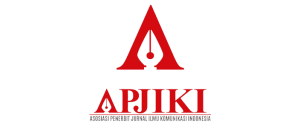Body Image dalam Video Klip LOONA "Butterfly"
DOI:
https://doi.org/10.30656/lontar.v11i1.5756Keywords:
Body Image, Reception Analysis, Adolescent FansAbstract
Mass media builds the construction of women's body images. Women's beauty is judged by certain indicators, including slim bodies, fair skin, and straight hair. The unrealistic body image displayed by the mass media has a negative impact on the audience, especially female adolescents. Meanwhile, LOONA's “Butterfly†music video defy beauty standards. Adolescent fans tend to internalize the values ​​that exist in the figure of the idol. This study aims to explain the reception of LOONA's teenage fans for aspects of body image in LOONA's "Butterfly" music video. The theory used in this study is reception analysis. This research was conducted qualitatively through in-depth interviews with female adolescent fans of LOONA. The results of the study show that the position of reception of LOONA's adolescent fans on aspects of body image in LOONA's "Butterfly" music video is dominated by a dominant position. The reception of LOONA's adolescent fans is influenced by the frameworks of knowledge, relations of production, and technical infrastructure.
References
Absari, A. (2013). Identitas Sosial Penggemar K-pop (Perbandingan antara Penggemar K-Pop yang Tergabung dalam Komunitas KFM dan Penggemar K-Pop yang Tidak Tergabung dalam Komunitas KFM). Skripsi. Universitas Islam Negeri Maulana Malik Ibrahim Malang.
Bangun, J. R. V. (2018). Pengaruh Peningkatan Jumlah Wisatawan Tiongkok ke Korea Selatan Terhadap Perekonomian Korea Selatan. JOM FISIP, 5(2), 1-15.
Coomber, K., & King, R. M. (2008). The Role of Sisters in Body Image Dissatisfaction and Disorder Eating. Sex Roles, 59(1), 81- 93. https://doi.org/10.1007/s11199-008-9413-7.
Denich, A. U., & Ifdil, I. (2015). Konsep Body Image Remaja Putri. Jurnal Konseling dan Pendidikan, 3(2), 55-61. https://doi.org/10.29210/116500.
Fakhira, A. (2019). Standar Cantik Korea dalam Webtoon The Secret of Angel. Karya Tulis. Akademi Bahasa Asing Nasional.
Fitria, S. (2020). Konstruksi Standar Kecantikan dalam Cerpen Fenghuang Karya Wendoko. Prosiding Seminar Nasional Sasindo, 1(1), 225-231. http://dx.doi.org/10.32493/sns.v1i1.7880.
Jung, J. (2006). Cross-Cultural Comparisons of Appearance Self-Schema, Body Image, Self-Esteem, and Dieting Behavior Between Korean and U.S. Women. Family and Consumer Sciences Research Journal, 34(4), 350-365. https://doi.org/10.1177/1077727X06286419.
Lin, L., & Reid, K. (2009). The Relationship Between Media Exposure and Antifat Attitudes: The Role of Dysfunctional Appearance Beliefs. Body Image, 6(1), 52–55. https://doi.org/10.1016/j.bodyim.2008.09.001.
Maulidya, T. (2019). Diplomasi Publik Korea Selatan Melalui Teknologi Operasi Plastik. Skripsi. Universitas Muhammadiyah Malang.
Moy, G. (2015). Media, Family, and Peer Influence on Children’s Body Image. Disertasi. Rutgers University-Camden Graduate School.
Ninggalih, R. (2011). Waspada Demam Idola. Dalam http://majalah1000guru.net/2011/10/waspadai-demam-idola, akses 28 Februari 2020, pukul 08.09 WIB.
Nourmalita, M. (2016). Pengaruh Citra Tubuh terhadap Gejala Body Dismorphic Disorder yang Dimediasi Harga Diri pada Remaja Putri. In Seminar ASEAN 2nd Psychology & Humanity. Psychology Forum UMM (pp. 546-555). Dalam http://mpsi.umm.ac.id/files/file/546-%20555%20melina.pdf, akses 19 Januari 2020, pukul 10.56 WIB.
PolakeviÄová, I. (2015). Body Image in The Media-Selected Aspects of The Paralels of The Myth of Beauty. Revue spoloÄenských a humanitných vied, 1.
Republika. (2020). Jumlah Penggemar Hallyu di Dunia Mencapai 90 Juta Orang. Dalamhttps://republika.co.id/berita/pl5ham383/jumlah-penggemar-emhallyuemdi-dunia-mencapai-90-juta-orang, akses 10 Februari 2020, pukul 16.07 WIB.
Sari, T. Y. (2009). Hubungan Antara Perilaku Konsumtif dengan Body Image Pada Remaja Putri. Skripsi. Universitas Sumatera Utara.
Soetjiningsih. (2004). Tumbuh Kembang Remaja dan Permasalahannya. Jakarta: Sagung Seto.
Sukamto, M. (2006). Citra Tubuh Perempuan di Media Massa. Anima, Indonesian Psychological Journal, 21(3), 299-305.
Valentina, A., & Istriyani, R. (2017). Gelombang Globalisasi ala Korea Selatan.
Jurnal Pemikiran Sosiologi, 2(2), 71-86. https://doi.org/10.22146/jps.v2i2.30017.
Downloads
Published
Issue
Section
License
By submitting an article to the journal, the author(s) agree to transfer the published article's copyright to the journal, which will act as the publisher. This means the journal will have the right to publish the article in various forms, including reprints. The journal will maintain the publishing rights to the published articles.
In line with the license, authors and third parties (readers, researchers, and others) are allowed to share and adapt the material. In addition, the material must be given appropriate credit, provided with a link to the license, and indicated if changes were made. If authors remix, transform, or build upon the material, authors must distribute their contributions under the same license as the original.





